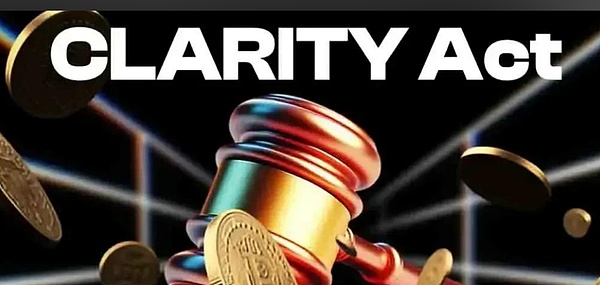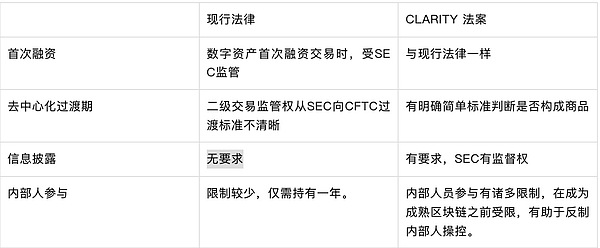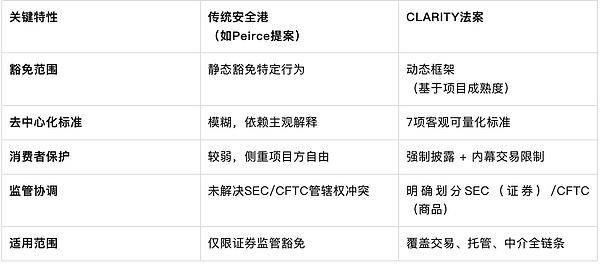Author: Zhang Feng
Recently, the U.S. House of Representatives passed an important new "market structure" bill, the "CLARITY Act" (Digital Asset Market Clarity Act), which aims to establish a clear regulatory framework for the digital asset market. The bill has now entered the Senate review stage, where the Senate is drafting its own version of market structure legislation, and the CLARITY Act will serve as a reference.

The core value of the CLARITY Act is to provide a compliance pathway for decentralized projects, but it is not a direct improvement of the traditional "safe harbor" bill. Instead, it introduces a "safe harbor"-like exemption mechanism in cryptocurrency regulation and builds a more systematic regulatory framework on this basis. Its core is to provide a compliance pathway for decentralized projects through a "control-based maturity framework" and DeFi exemption clauses, while optimizing the shortcomings of previous bills.
I. Main Content of the "Safe Harbor" Mechanism
DeFi Developer Exemptions. Clearly exempts the compliance obligations of the following roles, forming a safe harbor protection: blockchain underlying code developers; node operators and oracle service providers; front-end interface developers of DeFi protocols; non-custodial wallet service providers.
For example, companies like Uniswap Labs that only provide interfaces do not need to register as exchanges, avoiding being classified as "unregistered securities intermediaries."
"Mature Blockchain System" Certification. Projects can achieve a regulatory transition from securities to commodities by proving they meet three standards: decentralized control (no single entity dominates); open-source code; automated operation. After certification, tokens fall under CFTC regulation, and SEC exits jurisdiction, essentially providing a regulatory exit path for compliant projects.
The unique attributes of existing laws and the CLARITY Act (if passed) regarding blockchain systems are compared as follows.

II. Improvements Over Traditional Safe Harbor Proposals
Compared to previous safe harbor proposals like the "Blockchain Regulatory Certainty Act," the breakthrough of the CLARITY Act lies in:
Dynamic Regulatory Framework. Traditional safe harbors only provide static exemptions (such as the Hester Peirce proposal), while CLARITY introduces the concept of "control-based maturity," adjusting regulatory intensity based on the project's development stage: early centralized stage applies SEC's strict disclosure and insider trading restrictions; mature decentralized stage shifts to commodity regulation, with reduced obligations. It sets seven objective standards (such as governance rights distribution, code control rights) to avoid subjective judgment.
Enhanced Consumer Protection. Requires project parties to disclose key information (such as token economics, risks) during the early stages; restricts insiders from selling tokens before the project matures, preventing profit from information asymmetry.
Filling Regulatory Gaps. Clearly requires centralized exchanges (like Coinbase) to register with the CFTC and comply with capital reserve and anti-fraud rules, addressing regulatory gaps similar to those seen with FTX.

III. Areas Not Fully Covered
State-Level Regulation Not Prioritized for Exemption. Although DeFi protocols are exempt from federal intermediary regulation, state-level regulations (such as New York's BitLicense) may still apply, leading to compliance fragmentation.
Non-Digital Commodity Assets Not Covered. The bill only applies to "digital commodities" (such as Bitcoin, Ethereum), while tokenized securities, derivatives, etc., remain under SEC jurisdiction, without providing a conversion path.
Anti-Money Laundering (AML) Challenges. The anonymity of DeFi conflicts with traditional KYC mechanisms, and the bill does not propose an adaptation plan, potentially leading to illegal funding risks.
IV. Coexistence of Innovation and Limitations
The CLARITY Act can be seen as an advanced version of the safe harbor mechanism: by providing a dynamic framework and objective standards, it addresses the ambiguity of traditional safe harbors, balancing innovation and protection; however, it also retains challenges such as state-level regulation and anti-money laundering, which require subsequent legislative supplements.
Its core value lies in providing a predictable compliance pathway for decentralized projects while forcing centralized institutions to accept strict regulation, potentially ending the long-standing fragmentation of U.S. cryptocurrency regulation. If passed by the Senate, it will become a key step in reshaping the global cryptocurrency competitive landscape following the GENIUS Act.
免责声明:本文章仅代表作者个人观点,不代表本平台的立场和观点。本文章仅供信息分享,不构成对任何人的任何投资建议。用户与作者之间的任何争议,与本平台无关。如网页中刊载的文章或图片涉及侵权,请提供相关的权利证明和身份证明发送邮件到support@aicoin.com,本平台相关工作人员将会进行核查。




